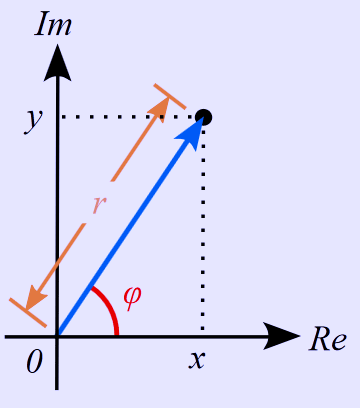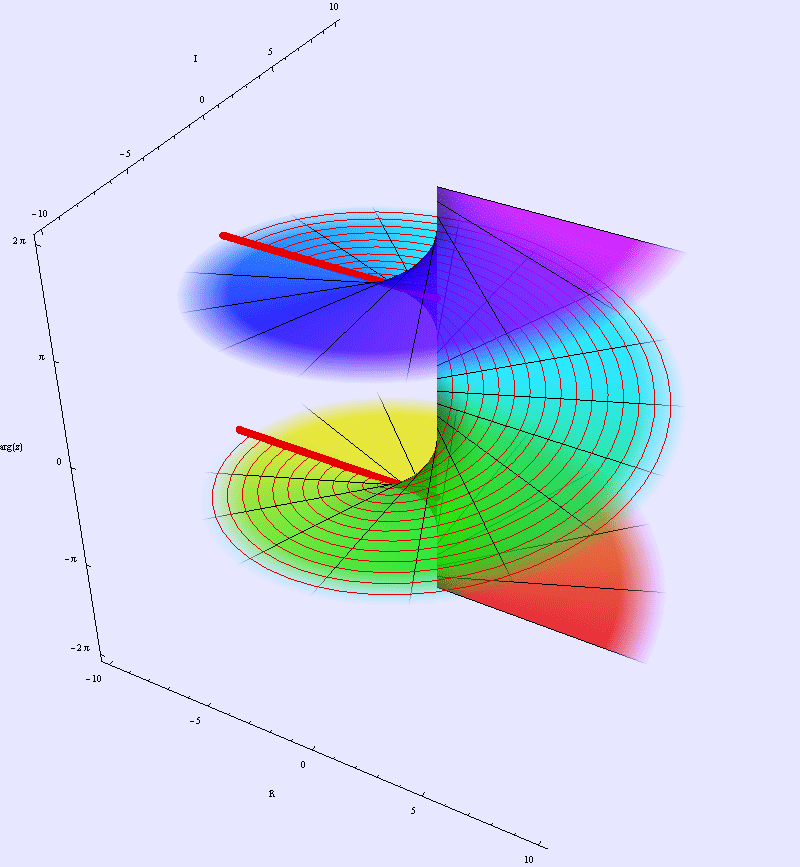.
Argument (complex analysis)
In mathematics, arg is a function operating on complex numbers (visualised as a flat plane). It gives the angle between the line joining the point to the origin and the positive real axis, shown as φ in figure 1 opposite, known as an argument of the point (that is, the angle between the half-lines of the position vector representing the number and the positive real axis).

Figure 1. This Argand diagram represents the complex numbers lying on a plane. For each point on the plane, arg is the function which returns the angle φ. (*)
Definition
Arguments are defined in two equivalent ways:
Geometrically, in relation to an Argand diagram, arg z is the angle φ from the positive real axis to the vector representing z. The numeric value is given by the angle in radians and is positive if measured anticlockwise.
Algebraically, an argument of the complex number z = x + iy is any real quantity φ such that
\( z = x + i y = r \cos \phi + i r \sin \phi \ \)
for some positive real r. The quantity r is the modulus of z, written
\( r = |z| = \sqrt{x^2 + y^2} \ . \)
The names amplitude[1] or phase[2] are sometimes used equivalently.
Under both definitions, it can be seen that the argument of any (non-zero) complex number has many possible values: firstly, as a geometrical angle, it is clear that whole circle rotations do not change the point, so angles differing by an integer multiple of 2π radians (a complete circle) are the same. Similarly, from the periodicity of sin and cos, the second definition also has this property.
Principal value
Figure 4. The principal value Arg of the blue point at 1+i is π/4. The red line here is the branch cut and corresponds to the two red lines in figure 2 seen vertically above each other).
Because a complete rotation around 0 leaves a complex number unchanged, there are many choices which could be made for φ by circling the origin any number of times. This is shown in figure 2, a representation of the multi-valued (set-valued) function, where a vertical line cuts the surface at heights representing all the possible choices of angle for that point.
When a well-defined function is required then the usual choice, known as the principal value, is the value in the open-closed interval (−π, π], that is from −π to π radians, excluding −π itself (−180 to +180 degrees). This represents an angle of up to half a complete circle from the positive real axis in either direction, the angle φ is constrained to lie between −π and π radians. This portion of the surface is shown hatched in red in figure 2, and projected onto the plane in figure 4.
The principal value sometimes has the initial letter capitalized as in Arg z, especially when a general version of the argument is also being considered. Note that notation varies, so arg and Arg may be interchanged in different texts.
Some authors define the range of the principal value as being in the closed-open interval [0, 2π).
The set of all possible values of the argument can be written in terms of Arg as:
\( \arg{z}=\{\operatorname{Arg} z+2\pi n:n\in \mathbb Z\}. \)
Covering space

Figure 2. The arguments of the complex plane are plotted vertically. arg measures the angle of points, shown by the fact that the outward radial lines, which have constant angle to the real axis, lie on the surface. The layered structure shows that each point has infinitely many arguments, each one corresponding an intersection between a vertical line through the point and the sheet. The red hatching indicates the surface corresponding to the principal value. See larger version.
In informal situations, arg may be left not well-defined, for instance arg z(t) where z depends on a parameter t may change by 2π every time z goes around the origin. This idea can be made more precise by considering z(t) as being defined not on the complex plane but on a covering space. Polar coordinates excluding the origin and with an unconstrained angle provide such a space, in this case arg is defined by:
\( \begin{align} \arg \colon \mathbb{R}^+\times\mathbb{R} &\to \mathbb{R} \\ (r,\ \phi) &\mapsto \phi \end{align} \)
The covering space has as base space the punctured complex plane. This is equivalent to the product of a positive non-zero radius and an angle on a unit circle that is:
\( \mathbb{C}\backslash\{0\} = \mathbb{R}^+ \times \mathbb{S}^1 \)
The principal value Arg then maps the unit circle component of this representation to the interval (−π, π].
Computation
The principal value Arg of a complex number given as x+iy is normally available in programming languages using the function atan2( ) or some language specific variant. The value of atan2(y, x) is the principal value in the range (−π, π].
Many texts say the value is given by arctan(y/x), as y/x is slope, and arctan converts slope to angle. This is correct only when x > 0, so the quotient is defined and the angle lies between −π/2 and π/2, but extending this definition to cases where x is not positive is relatively involved. Specifically, one may define the principal value of the argument separately on the four half-planes x > 0, x < 0 (separated into two quadrants if one wishes a branch cut on the negative x-axis), y > 0, y < 0, and then patch together.
\( \operatorname{Arg}: \mathbb{C} \backslash \{0\} \to (-\pi,\pi] \)
\( \operatorname{Arg}(x + iy) = \operatorname{atan2}(y,x) = \begin{cases} \arctan \left( y/x \right) & \qquad x > 0 \\ \pi/2 - \arctan \left( x/y \right) & \qquad y > 0 \\ -\pi/2 - \arctan \left( x/y \right) & \qquad y < 0 \\ \pi + \arctan \left( y/x \right) & \qquad x < 0, y \ge 0 \\ -\pi + \arctan \left( y/x \right) & \qquad x < 0, y < 0 \\ \text{undefined} & \qquad x = 0, y = 0 \end{cases} \)
For the variant where Arg is defined to lie in the interval [0, 2π), the value can be found by adding 2π to the value above when it is negative.
Alternatively, the principal value can be calculated in a uniform way using the tangent half-angle formula, the function being defined over the complex plane but excluding the origin:
\( \operatorname{Arg}(x + iy) = \begin{cases} 2 \arctan \left( \frac{y}{\sqrt{x^2+y^2}+x} \right) & \qquad x > 0 \text{ or } y \ne 0 \\ \pi & \qquad x < 0 \text{ and } y = 0 \\ \text{undefined} & \qquad x = 0 \text{ and } y = 0 \end{cases} \)
This is based on a parametrization of the circle (except for the negative x-axis) by rational functions. This version of Arg is not stable enough for numerical use but can be used in symbolic calculation. In many programming libraries there is a function called atan2 which performs an equivalent computation.
Identities
One of the main motivations for defining the principal value arg is to be able to write complex numbers in modulus-argument form (the modulus of z = x + iy is |z| = √(x2 + y2), the length of the vector on the Argand diagram). Hence for any complex number z,
\( z = \left| z \right| e ^ { i \arg \left( z \right) } . \)
This is only really valid if z is non-zero but can be considered as valid also for z = 0 if arg(0) is considered as being an indeterminate form rather than as being undefined.
Some further identities follow. If z1 and z2 are two non-zero complex numbers then
\( \arg\left(z_1 z_2\right) = \arg(z_1) + \arg(z_2) \pmod {2\pi} \) , and
\( \arg\left(\frac{z_1}{z_2}\right) = \arg(z_1) - \arg(z_2) \pmod {2\pi} . \)
If z ≠ 0 and n is any integer then
\arg\left(z^n\right) = n \arg(z) \pmod {2\pi} . \)
Example
\( \arg\left(\frac{-1- i}{i}\right) = \arg(-1-i) - \arg(i) = -\frac{3\pi}{4} - \frac{\pi}{2} = -\frac{5\pi}{4}\ \stackrel{\pmod {2\pi}}{\longrightarrow}\quad \frac{3\pi}{4}. \)
References
Notes
^ Knopp, Konrad; Bagemihl, Frederick (1996). Theory of Functions Parts I and II. Dover Publications. p. 3. ISBN 0-486-69219-1.
^ Dictionary of Mathematics (2002). phase.
Bibliography
Ahlfors, Lars (1979). Complex analysis : an introduction to the theory of analytic functions of one complex variable (3rd ed.). New York;London: McGraw-Hill. ISBN 0070006571.
Beardon, Alan (1979). Complex analysis: the argument principle in analysis and topology. Chichester: Wiley. ISBN 0471996718.
Borowski, Ephraim; Borwein, Jonathan (2002) [1st ed. 1989 as Dictionary of Mathematics]. Mathematics. Collins Dictionary (2nd ed.). Glasgow: HarperCollins. ISBN 000710295X.
External links
Weisstein, Eric W., "Complex Argument" from MathWorld.
Retrieved from "http://en.wikipedia.org/"
All text is available under the terms of the GNU Free Documentation License

